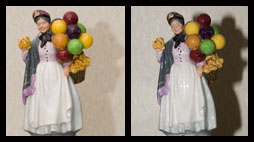Flash units emit harsh, directional light. When fired directly at a subject they may produce well-defined and unsightly dark shadows on any nearby background. It is therefore generally advantageous to diffuse or soften the output by spreading the light. This results in softer background shadows with less-well-defined edges. An example of the difference a simple diffuser can make to an image is given below. The shadows in the image on the left are clearly softer, resulting in a more attractive image.
 The manufacturers of flash units may claim that diffusers are unnecessary because they merely decrease the output level. This results in the controlling electronics increasing output to maintain the correct exposure. While this is undoubtedly true, and the the maximum working distance between the flash head and the subject is reduced by the presence of a diffuser, experience shows that the illumination does becomes softer and more attractive. Flash units equipped with diffusers, and tilted to 45 degrees, provide wrap-around light and particularly soft shadows. Another approach is to cut a wedge-shaped piece of white card, or thin polystyrene foam, and attach it to the flash head in a suitable manner - usually wrapped half way around the head to provide an effective fill light from one side. The diffuser can be held in place by a strong elastic band.
The manufacturers of flash units may claim that diffusers are unnecessary because they merely decrease the output level. This results in the controlling electronics increasing output to maintain the correct exposure. While this is undoubtedly true, and the the maximum working distance between the flash head and the subject is reduced by the presence of a diffuser, experience shows that the illumination does becomes softer and more attractive. Flash units equipped with diffusers, and tilted to 45 degrees, provide wrap-around light and particularly soft shadows. Another approach is to cut a wedge-shaped piece of white card, or thin polystyrene foam, and attach it to the flash head in a suitable manner - usually wrapped half way around the head to provide an effective fill light from one side. The diffuser can be held in place by a strong elastic band.
For close work, even a white handkerchief stretched across a flash head, and once again held in place with an elastic band, can be effective. The flash output is increased by the electronics to compensate for the attenuating effect of the material, but the increased spreading of the light results in softer illumination.






